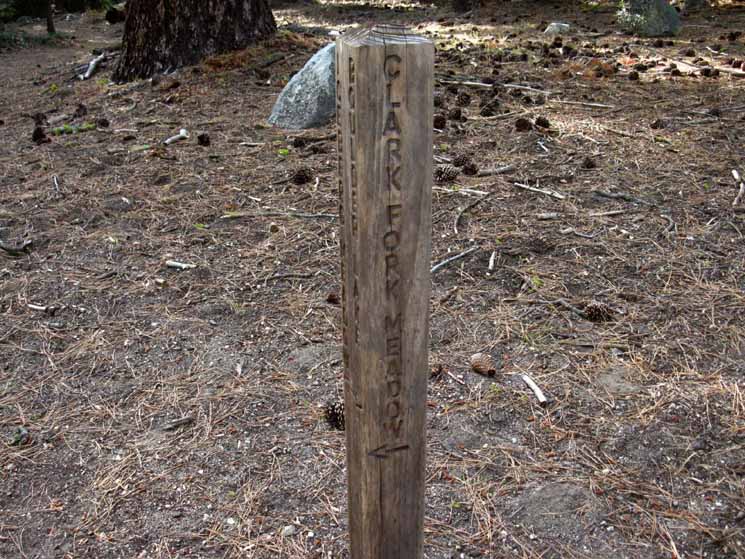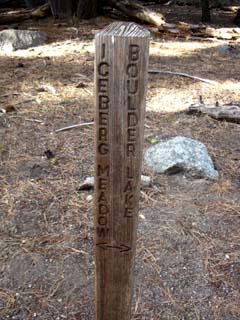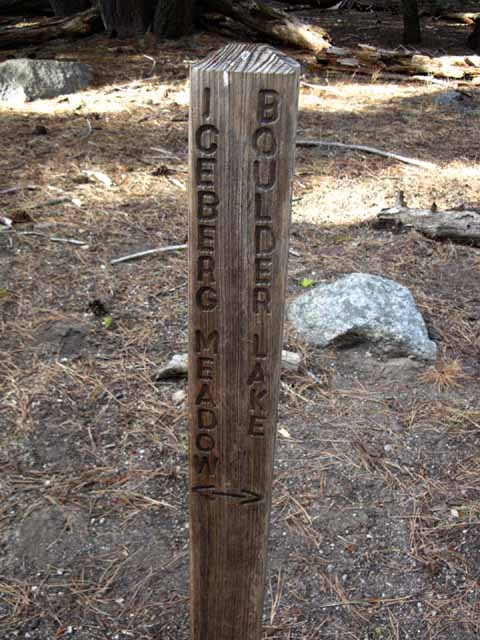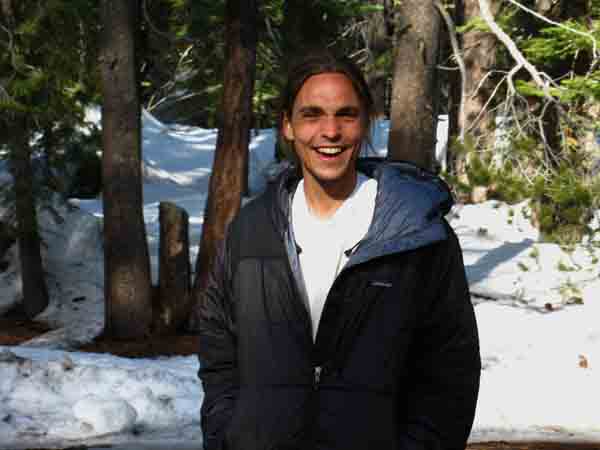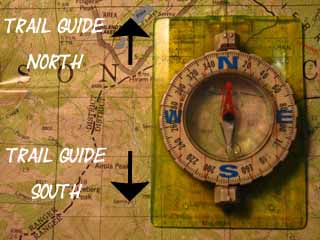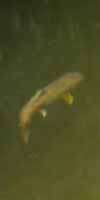
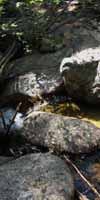

Leavitt Massif rising in center-Right background.
The Trails
Guide
Maps
Miles/Ele
Permits
Resupply
Forum
Current Weather Conditions
Weather Notes
Northern High Sierras
Central High Sierras
Southern High Sierras
Gear
Gear List
Gettin Started
Layering
Discussion
Testing yourself and your gear
Gear Reviews
Backpacking
Boulder Lake Trail Junction
South
climbing up to the
Lower Ford of the Clarks Fork of the Stanislaus River
HIKING
&
BACKPACKING
SOUTH CARSON ICEBERG WILDERNESS
The Tahoe to Yosemite Trail from Lake Alpine to Saint Marys Pass
Languages
Languages
Trail Arts
The art of walking
Physical Preperation
Trail Skills
The trail
Off the trail
Scrambling
Maps
Navigation
Camp skills
Food
Resupply
Food
Other
Photo Catagories
Trail Stories
Trail Culture
News and Science
Links
Groups
Books
Terms and Conditions of Use
| Trail Guide INDEX Highway 4 to Highway 108 |
Trail Guide |
Trail Guide |
7.5 Topo Map Middle Clarks Fork 30 min Map Lake Alpine to Saint Marys Pass |
7.5 Topo |
TYT
ALL |
TYT |
RESUPPLY |
National
|
|
| Sonora Pass
Region Backpacking Map |
|||||||||
Boulder Creek Trail Junction
SOUTHBOUND
Tahoe to Yosemite Trail
| ENTERING UNMAINTAINED AND UNTRAILED SEGMENTS OF TRAIL Stanislaus National Forest, Carson-Iceberg Wilderness See The BACKPACKER'S FORUM for HIKER UPDATES & REPORTS Skip the Introduction: Hiking the TYT Trail South |
| South of Boulder Creek
South on the TYT |
The TYT at Boulder Lake Trail Junction WHERE
Alternative Route PCT DIVERSION AROUND TYT
WE'RE ON THE TYT
TYT SOUTH Less Trail the Further South we Go
Ready, Steady, Go Requirements
Potential Extra Difficulties
Variable Potential Workload
A High Level of Standard Difficulties
Saint Marys Pass Trailhead
Iceberg Meadow NORTH TYT Topping A local trailhead
Web of Trails Hub of Boulder Lake
More on
|
Index
Vital Maps, Information, and Statistics ALONG THE TAHOE to YOSEMITE TRAIL
Backpacker
The Tahoe to Yosemite Trail through the Carson-Iceberg Wilderness. |
||||||||||||||||||||||||||||||||||
The
|
||||||||||||||||||||||||||||||||||||||||||
Information TYT Boulder Lake trail junction 6960 feet
Road Map Highway 108 Trailheads The above are our Trail Options from Boulder Creek
|
Looking for a Challenge?
These 8.69 miles climbing 3440 feet South from the Boulder Lake trail junction over the 10,400 foot Saint Marys Pass and down to the 9440 feet at the Saint Marys Pass Trailhead on Highway 108 are the last of our 34.28 mile hike on the Tahoe to Yosemite Trail across the Western flank of the Carson Iceberg Wilderness. This section started at the Silver Trailhead on the East Shore of Lake Alpine.
These last eight miles are some serious miles, both in terms of physical and navigational demands. Be ready for them.
In my opinion this short eight mile segment of trail contains the toughest miles along the whole Tahoe to Yosemite Trail. The TYT through Summit City Creek to Camp Irene is the longest section of difficult navigation, but this short segment of trail contains the hardest miles of challenging hiking combined with navigational difficulty.
Hiking South of the Boulder Creek trail junction the TYT loses maintenance support above the unmarked trail to Eureka Valley. The trail fades out progressively as we climb through the three fords we encounter hiking from the Boulder Creek trail junction into the North edge of the Clarks Fork Meadow.
South of the ford on the North edge of Clarks Fork Meadow we enter thel heart of the Clarks Fork Headwaters Bowl on our way to find Saint Marys Pass atop its surrounding cliffs.
Above the lowest ford we have a short section through a spooky forested flat as the unmaintained trail deteriorates further approaching the steep climbing segment that brings up to the North edge of Clarks Fork Meadow.
Only faded memories of trail bring us up across this very rough, steep, but short bit of terrain climbing up to the North edge of Clarks Fork Meadow. This segment of trail from the lower ford to the Northern edge of Clarks Fork Meadow challenges our ability to find and follow bits of the route up to our next fording point on the North edge of Clarks Fork Meadow.
A Nice Local Destination
Climbing to the North edge of Clarks Fork Meadow we find a nice campsite looking out over the steep segment we just climbed, surrounded by the beautifully shaped granite formations lining the upper canyon wall. This campsite, its view, and the North edge of the meadow all come together where the flow of the Clarks Fork out of its namesake meadow is funneled by unique granite terrain into and through a narrow rocky channel inset into the terrain.
This pocket in the rock runs the Clarks Fork over a miniature inset waterfall into an area of sweet pooling, then through a "mini-gorge," all inset into the granite channel below us. At the end of the mini-gorge the Clarks Fork begins its chaotic plunge down the steep canyon below the North edge of its namesake Meadow, down to where it calms a bit above the middle ford.
We're at the confluence point of an amazing juxtaposition of different kinds of beauty swirling around us and through the little waterfall at our feet at this sweet scenic point overlooking the maximal grandeur of the descending valley of the Clarks Fork of the Stanislaus River.
A stunning location.
And, if we are lucky a good breeze out of the Northwest will keep the mosquitoes of Clarks Fork Meadow at bay as we let the beauty and isolation of this special place sink into our soul and revive the spirit within.
I hate it when mosquitoes pump blood out as beauty is trying to sink in.
| comments | Forum |
What's Important
From the lowest ford our ability to find the best way up to this premium overlook and campsite on the North edge of Clarks Fork Meadow determines how "hard" this section will be.
This route is not objectively rateable, as backpackers are likely to wander off the optimal route into difficult terrain, then dispute trail ratings, while it was in fact problems with their ability to find the route that increased the difficulty of their particular experience in the first place.
We can make this segment very difficult.
If we stay on the easiest route between visible indications of the remaining bits of the trail this will be a much easier hike than if we wander off the route of the old trail.
Good route-finding skills through here will save a lot of time and energy if properly deployed, which becomes vitally important when we are carrying the weight of a long distance backpack.
Stubborn as a Bull
Oh, we'll find our way up, even if we wander off the best route, but each of our variations from the optimal route will wring copious amounts of sweat and energy out of us. We're going to waste a lot of energy if we can't find and stay on the best route up this rough unmaintained trail as it degrades into route.
If we cannot stay on the optimal route from the lower ford up to the Clarks Fork Meadow this will indeed be a very very difficult section to hike. Route finding skills are very important along this unmaintained section of the Tahoe to Yosemite Trail's route.
Harder or Hard
Don't make any mistake about it: even if we do find and follow the optimal route through the terrain the difficulty level from the lowest ford to Saint Marys Pass is still a "Hard 1," which I rate as the hardest level of difficulty of the hardest grade of backpacking. The rating for this segment of trail is earned by both the difficulty of the terrain as well as the level of difficulty its route finding and navigation challenges present.
Notes
on
hiking unmaintained trails/routes
Hey, I've always said that "strong makes up for stupid," meaning that we can make a lot of errors and do stupid things and still get through if we have the extra strength to spend.
On the other hand, you could be screwed if you don't have that extra energy and make bad decisions. I would not try to backpack through this if I was weak and under-experienced.
I've actually hiked this segment while "broken," but I've done this kind of thing for decades...
Clarks Fork Meadow
END of TRAIL
Climbing to the North edge of Clarks Fork Meadow we find some flat terrain, our middle fording point, and the end of the few remaining bits of trail remnants up here at the end of the unmaintained route. The trail South ends here.
South of the North edge of Clarks Meadow there's no trail, and we will encounter no wild ducks, blazes, of bits of trail hiking around the North edge of the middle meadow until we get to the South end of the middle meadow.
There we pick up
a few widely dispersed "wild ducks" and find bits of use trail up to help guide us up around the North edge of the upper meadow tapering into the uppermost ford beyond.
I say "around" the middle portion of Clarks Fork Meadow because that is best route, around its North edge, the Southbound backpacker's Left, hiking South from the North edge of Clarks Fork Meadow..
Route, Wild Ducks, and Use Trail
The ducks marking this section of the route up to and then above the middle meadow are what I call "wild ducks." Wild Ducks are mostly located to mark key locations along the route such as fords and bends in a route rather than following and marking the position of a continuing trail.
Wild ducks are located at key positions along a route rather than at regular intervals, if they exist at all. Ducks can be quite transitory.
All the trail conditions described here may have deteriorated significantly. There may be no wild ducks or bits of use trail, yet our route will still carry us through if we stay on it.
One good Winter followed by a powerful and fertile Spring Thaw can change everything.
It's only 2.71 miles from the North edge of Clarks Fork Meadow to where we finally join the maintained trail to Saint Marys Pass Trailhead. There's a lot of experiences packed into this small space. Across this distance we'll be following wild ducks, when they're available, but will mostly be relying on our own estimation of the best route based our our observations and assessments.
The guide below follows the wild ducks and use trail marking the current location of the route of the Tahoe to Yosemite Trail.
These 2.71 miles can seem, and be a lot longer if we are unable to stay on-route.
| Trail definitions on this guide. |
Unmaintained TYT Trail Reports |
| comments | Forum |
Transportation
Continuing
South on the TYT from Saint Marys Pass
We hike through the Saint Marys Pass Trailhead exiting the South end of the Carson Iceberg Wilderness onto Highway 108.
The Southbound Tahoe to Yosemite Trailhead into the next wilderness to our South, Emigrant Wilderness, is offset nine miles West down Highway 108 from the Saint Marys Trailhead.
The Tahoe to Yosemite Trail continues South through Kennedy Meadows Pack Station to the Kennedy Meadow Trailhead.
Conveniently, the Kennedy Meadows Pack Station and Resort is also our next Resupply spot, where we will pick up the Resupply Bucket we sent to ourselves via Kennedy Meadows to provision our next and last section of the Tahoe to Yosemite Trail, the 72 mile section from Kennedy Meadows to Tuolumne Meadows.
I really enjoy Kennedy Meadows Pack Station, its people, its services and food, and the people who pass through there. That means I will likely spend two nights somewhere near the Pack Station to enjoy all of these qualities.
Down to KM
I strongly suggest hitch-hiking rather than hiking down Highway 108 to Kennedy Meadows Pack Station, mainly to avoid getting run over by tourists on this narrow twisting road. You are better off in the passenger seat than on the fender. I meet the nicest people hitching the mountain roads, and especially along Highway 108. There is no public transportation anywhere near here.
I am trying to talk Bloom into running a daily shuttle to and from Sonora Pass to Kennedy Meadows, and into opening a small, free campground for PCT and other through hikers on the beach at Kennedy Meadows Pack Station. He has not yet instituted these policies (2015), but will allow employees to run hikers to and from the pass, and let through hikers camp on the beach if they keep quiet and clean up.
Inside Info.
Through hikers can ask Bloom if they can stay on the beach. Don't ask Joan. Ask Matt.
Hike to Kennedy Meadows
If we really want to hike to Kennedy Meadows we can take the trail. We'll hike .75 of a mile East up Highway 108 from the Saint Marys Pass to Sonora Pass on the Sierra Crestline, then turn South over Leavitt Peak on the PCT. Hiking 7.97 miles South on the PCT brings us over Leavitt Peak to the trail junction at the top of Kennedy Canyon at the base Leavitt's South Flank.
Rather than turning East here down Kennedy Canyon following the route of the Southbound PCT we turn West to hike 8.39 miles past Kennedy Lake to the TYT at Summit Creek (map), which is located 2.67 miles South of Kennedy Meadows Pack Station along the route of the TYT.
The Sonora Pass Trailheads Map below lays out this alternative hiking route to KM, gives us some context on the 9 mile offset separating the Saint Marys Pass Trailhead at the end of our Carson Iceberg Wilderness section from the resumption of the Southbound TYT through Kennedy Meadows Pack Station, and shows us the wide variety of routes we can explore crossing the High Emigrant Wilderness before they all come together in the top of Jack Main Canyon.
Sonora Pass Trailheads Hiking Map
USGS 30 minute backpacking map
Click the black-dotted trail routes for detailed hiking maps, and the red dots for guide information on the map above, and on all the large-scale 30 minute maps.
Clarks Fork Road
Degrees of Pedesterian Isolation
Hitch-hiking into and out of the Clarks Fork Trailhead at the end of the Clarks Fork Road is only a task for the patient. It's a few miles walk down from the Clarks Fork Trailhead to the much busier car campgrounds at Sand Flat and the nearby trailhead on Arnot Creek, where we are much more likely to get a ride out to Highway 108. If we stay at the Clarks Fork Trailhead we may end up waiting a long time for a ride out of there, and especially so during the off-season.
The end of the Clarks Fork Road draws lots of fishermen, and lots of folks from the many surrounding federal car campgrounds during the Summer high tourist season. There are always some cool folks out there then. I find it desolate and empty as the Summer comes to a close.
That is not always the case.
It is easier to hitch into and out of Saint Marys and Sonora Pass Trailheads located at the top of Highway 108. We have much better access to through-traffic than at limited traffic heading out to the isolated end of the Clarks Fork Road.
I've hitched out of the Clarks Fork Trailhead at the end of the road a few times over the last twenty years. It is a task for the patient during the off-season. The last time I was there during the height of Summer one fisherman handed me a cold beer, and two others offered me a ride out to Highway 108, all within six minutes of exiting the trailhead.
Yes! I was at Kennedy Meadows within an hour and a half, maybe two. Met a bunch of cool fisher-folks, too! Other times we must wait patiently.
Clarks Fork Road on a Road Map
Local Transportation
The Bottom Line
The car campers along the Clarks Fork are very much the same folks from the Valley that drove past and sneered or flipped us off when we were hitch-hiking East across The Big Valley to get into the mountains.
Thank god a few of them loosen up a bit up in the mountains, and that there are mountain folk up here who pick up hitch-hikers. If not, I'd still be standing somewhere alongside the Clarks Fork Road looking for a ride home...
Calculated Risks
Both hiking and hitch-hiking these roads have inherent dangers that you must measure, balance and choose based on your own comfort zone.
Read the Disclaimer.
Life is dangerous, and life on the edge of civilization is...
FANTASTIC...
| comments | Forum |
Great Rides through the Mountains
| Great Folks in the Mountains A Small Sample |
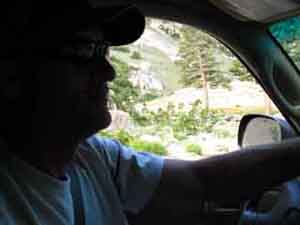 |
|||
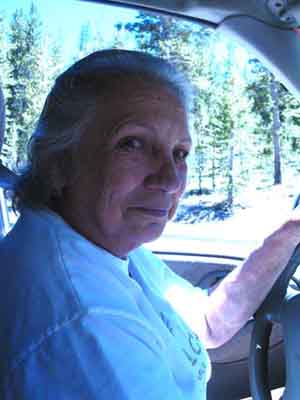 |
||||
| Damien Beauford and I discuss backcountry terrain and weather after he picked me up at Sonora Pass and dropped me off at Kennedy Meadows as he scouted the Sierra for his upcoming hunting trip. | ||||
Cool Folks Damien was cruising slow, studying the landscape, looking for signs of activities. Dee was driving from apex to apex as quickly as her skills and gear allowed. The mountains draw a lot of good people to and across them every Summer. These fine folks are a valuable part of my backpacking time. That includes you, Beverly! I look forward to meeting new friends in and around the mountains every year, a lot of times hitchhiking between, to, or from backpacking trips. The Sierra is like a social filter, filtering out huge amounts of urban idiots from the scope of daily experience, and highlighting those who do get through their own stupid social definitions. |
||||
DEE ! Dee was a pleasure to talk to, though she drove the mountains like Mario Andretti. Jesus, call her Grandma Lead foot! Dee go Fast! Look at the look on her face. |
| STEVO | ||||
Steve also does the music for the Tahoe to Whitney Videos.
It's funny, but I never stopped hitch-hiking since the late 1960s. Well, maybe because Waters is funny, and I'm DOA serious. I would not trade my fantastic experiences meeting folks for the convenience of a car. |
||||
Trail Miles Recap
8.69 tough miles South upriver from the Boulder Lake junction to Saint Marys Pass on Highway 108.
2.56 easy miles North from the Boulder Lake junction downriver to the Clarks Fork Trailhead at the end of Clarks Fork Road.
11.25 miles upriver from the End of the Clarks Fork Road to Saint Marys Pass Trailhead on Highway 108.
The campsite at the Boulder Lake trail junction is a good short-destination trip on its own for beginning backpackers. Nice day hikes into challenging terrain surround it, and it's easy to get to. Heck, push your short backpacking trip up to Boulder Lake with the goal being to scramble the upper West Flank of the Sierra from Boulder Lake up to the PCT and all around Boulder Peak.
That would be a fun little trip.
Lake Alpine to Saint Marys Pass
Backpacking Miles and Elevations
The Clarks Fork Road accesses the North end of this segment of trail and Saint Marys Pass its South end. Both are off of Highway 108. Check the roadmap to see the proximity of these two trailheads to each other along the |
Trail Data Collection I took hiking trips specifically designed to carefully explore this difficult segment of the Tahoe to Yosemite Trail route between the Boulder Creek trail junction and Saint Marys Pass on July 11 and 12 of 2012 and between July 9 and 15 of 2015 to collect current information on the routes's status. Prior to beginning the trail guide I'd had an informal policy of not taking pictures when I was worried or having a hard time over the years, so I'd leave the camera in the buttpack while navigating or crossing challenging terrain. I always considered the camera a distraction, if not an irritation. I resisted carrying what I called "electrics" out into the wilderness. Thus I had few images of this segment of the TYT. I have always been too busy looking for and figuring out the route to photograph it, even after I started carrying cameras. Damn 'lectrics. My original policy was, "Hike it if you want to see it." My priority had been focused on experiencing, rather than sharing. I would tell you how to get into the mountains so you could experience it yourself. The key is to experience it yourself. My original policy has radically and formally changed with the publication of Tahoe to Whitney. Now the descriptions of how to get into the mountains have merged with the best presentation of the beauty and experience of High Sierra Backpacking that I can weave together. I'm still left with some thin areas of photographic coverage of my favorite trails due to my stubborn nature. I was resistant to taking pictures or writing about the High Sierra experience for many years. Direction of Travel I almost always hike from North to South. Tahoe to Yosemite, Tahoe to Whitney, Meeks Bay to Kennedy Meadows, and so on. I've hiked most routes South to North at least once, to get that "Northbound" perspective, against walking all the trails Southbound at least five times. Because this 10 day trail guide scouting trip was designed and routed to fill in missing pieces of videos and images for the guide across the South Carson Iceberg Wilderness as well as incorporating a big loop around the High Emigrant Wilderness to verify and expand my coverage of the links between the TYT and PCT as they cross that fine wilderness, I was forced by circumstances to hike Northbound from Saint Marys Pass Trailhead on Highway 108 down to the Boulder Creek trail junction. My normal direction of hiking and the polarity of this guide is Southbound. Hiking the wrong direction and taking pictures? Short Trips? Alex has gone crazy! Such are the lengths I'll go to finish this trail guide project, once begun. The personal is public, the polarity of travel reversed!
Flow Problems Arrrrgg! I solved this problem by placing each video in its proper place in the sequence along our North to South direction of travel, though the content of each video walks through its specific section against the trail guide's normal direction of travel. Sigh. I'm hoping to get out soon to rectify this. A series of injuries and physical disasters has switched emphasis from collection of information to presentation, as possible within the requirements of recovery. Life is... Backpacking the Sierra can induce elevated states of consciousness. It also has the capacity to crush us physically and psychologically. Take care! Life is a two-way street! Trail Segment Notes Pack Weight and Trail Difficulty I have been taking my day pack along on my backpacking trips to better explore the key points along this route to better find, understand, explain and describe this subtle route, find it's character, explore it options, and avoid potential pitfalls. OMG Pack weight should be considered as a factor in rating trail difficulty, balanced against objective fitness level. The whole trail getting up the Clarks Fork is the most difficult degree of backpacking difficulty I cite, "Hard 1," and the last "crux" segment of this trail is a small bit of "class 3" hiking, in that we are using hands and feet while finding route.
Carrying heavy weight on "Hard 1" maintained trails significantly increases danger as well as difficulty. Bringing a heavy pack onto unmaintained and cross country routes exponentially increases our dangers.
|
Local and Long Distance Hikes
and
Backpacking Loops
around the
South Carson Iceberg Wilderness
Explore This Southern end of the Carson Iceberg Wilderness also offers some nice backpacking loop possibilities.
Exciting The Goal Where we start is almost irrelevant, as long as our start point is an accessible trailhead along the PCT or TYT. From our current location at Boulder Creek the nearest trailheads are at the end of the Clarks Fork Road and Saint Marys/Sonora Passes on Highway 108. The Southbound Loop That is our shortest Southern Carson Iceberg backpacking loop. This high and hard Saint Marys Pass to Sonora Pass loop is 23 miles long. We can start it from the Clarks Fork Road Trailhead at the end of the Clarks Fork Road. Or from the Saint Marys or Sonora Pass trailheads on Highway 108, depending on which direction we hike it. Carson Iceberg Wilderness Backpacking Map Northbound Loops We can hike from the Clarks Fork up to the PCT via Boulder Lake and turn North to return through one of the three main trails connecting the PCT to the TYT to our North. All of the trails running down Disaster*, Arnot, and Highland Creeks connect the PCT and TYT North of Boulder Lake. Looking at the Carson Iceberg Wilderness Map above makes me think it was designed to be explored and enjoyed by backpackers. Continuing North on the PCT past the Disaster Creek trail brings us to Wolf Creek Pass, where we can access the very top ends of both Disaster and Arnot Creek trails, as well as the Gardner Meadow Trailhead off the Highland Lakes Road, which leads us over to the Highland Lakes and trail down Highland Canyon to the TYT at Spicer Meadow Reservoir. Here at Highland Lakes we also find the relitively passive Headwaters of the mighty North Fork of the Mokelumne River flowing Northwest out of Highland Lake bending its course into the Mokelumne Wilderness. Nonetheless, we can continue North on the PCT past the series of Disaster Creek trail junctions to circle back around to the TYT through trails further to the North, such as the Disaster, Arnot, and Highland Creek trails. Trails to Highland, Arnot, and Disaster Creeks Craft Your Custom Route The Carson Iceberg Wilderness really is covered by an amazing web of trails offering a wide range of backpacking experiences for a wide range of backpacking skill and fitness levels.
*There are actually three main trails connecting the PCT to Disaster Creek. The first and Southernmost is an unmarked and unmaintained trail off the Southwest corner of Golden Canyon, then we come to the formal Disaster Creek trail junction along the PCT, and finally we can hike down the whole length of Disaster Creek via the Wolf Creek Pass trail junction. We've lots of backpacking route options in the Carson Iceberg Wilderness.
Loopy with Maps
My observations and notes about this section of the TYT between Lake Alpine and Saint Marys Pass, on this segment of trail at and above Boulder Creek, and observations about specific spots along this trail guide must be supplemented by observant backpackers via the backpacker's forum to keep each section of trail guide as accurate and up to date as possible. Post up your observations and experiences along the Clarks Fork to keep us all informed, and up to date about conditons along these challenging routes, and show us how various types of backpackers experience them:
Especially important are your experiences, tips, and insights about backpacking the unmaintained segments of the TYT through the Southern Carson Iceberg Wilderness. |
We Have Many route Options
from
Boulder Creek
Backpacking Trail Guide North |
|
East |
Backpacking Trail Guide South |
The Character Just What are We Getting Into? A Remote Route The first 1.31 mile segment consists of well maintained trail climbing up to the unmarked Eureka Valley trail junction from the Boulder Creek-Lake trail junction. The second 2.78 mile-long segment South of the Eureka Valley trail junction up to the first ford is composed of steadily deteriorating unmaintained trail. The short .66 of a mile third segment beyond the first ford quickly deteriorates into a route climbing steeply up to the North edge of Clarks Fork Meadow. This segment really begins to test our ability to follow optimal route through terrain. The fourth segment consists of the .42 of a mile from the North edge of the Clarks Fork Meadow The fifth segment brings us 1.14 miles from the upper ford to and up through the slot in the cliffs to the top of the Clarks Fork Headwaters Bowl. The final segment brings us 2.35 miles around the top of the headwaters bowl over to the maintained trail and down to the Saint Marys Pass Trailhead on Highway 108.
IMPORTANT STUFF The slot is a valid passable route up to and then off the floor of the upper headwaters bowl to the top of the cliffs. Finding it is critical. Iif we cannot find and stay on the route of the Tahoe to Yosemite Trail to the slot we will be forced to create our own alternative route each step of the way. That makes it terribly difficult. Or an even greater adventure. Which experience you have depends on you, and your perspective. Key Move Alt Routes My second choice, after the standard route of the TYT, would be to follow the Clarks Fork up to the center of the headwaters bowl. I will check out that potential route my next time out there. I did it about 18 years ago, which is too long ago to remember precise details. I do clearly recollect that it was a rough go picking my way through dense and steep terrain. Johnny recently described a route up the center/South wall (exact route to be determined), which Johnny shared in his trail report, and I referred to in my 2015 trail report in the forum. Alternative Route Notes
STANDARD TYT ROUTE The fifth segment of our hike between the Boulder Lake trail junction and Saint Marys Pass is the easiest part of this whole section. From where we hook up with Saint Marys Pass Trail we have a 1.14 mile hike South down this very well used trail (by day hikers) to the Saint Marys Pass Trailhead, which is situated a mile West of Sonora Pass on Highway 108. Saint Marys Pass Trailhead on Highway 108 Two Ways South Woo-Hoo or Boo-Hoo, it's all up to yoo-Hoo!
|
Segment I Images and Guide Film Route Distance 6960 to 7520 feet of elevation video duration
|
Backpacking Video
Eureka Valley Trail Junction 1.31 miles of maintained trail 9:08 |
|
Approaching Boulder Creek hiking Southbound on the Tahoe to Yosemite Trail route we come upon the trail leading 1.39 miles to our Left, Northeast up to Boulder Lake. Check out how this canyon appears in the terrain from further up the Clarks Fork. Another 1.35 miles of good condition unmaintained trail East past Boulder Lake brings us to the Pacific Crest Trail above the East fork of the Carson River. Check out the topo hiking map segment depicting this route. Boulder Creek trail junction to PCT An Below we are looking Southeast at the campsite on the South shore of Boulder Creek across the Boulder Lake trail junction post. Update
|
Boulder Creek Campsite
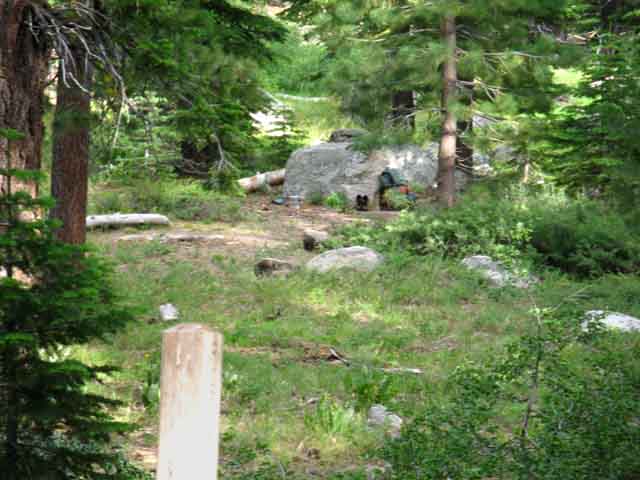 |
||
Boulder Creek Campsite Spending a lot of time on the trail requires camp shoes and camp socks. Both are part of my Standard Pack.
|
|
Looking South up the Clarks Fork of the Stanislaus. The main Boulder Creek Campsite is off to the Right on the far South bank. |
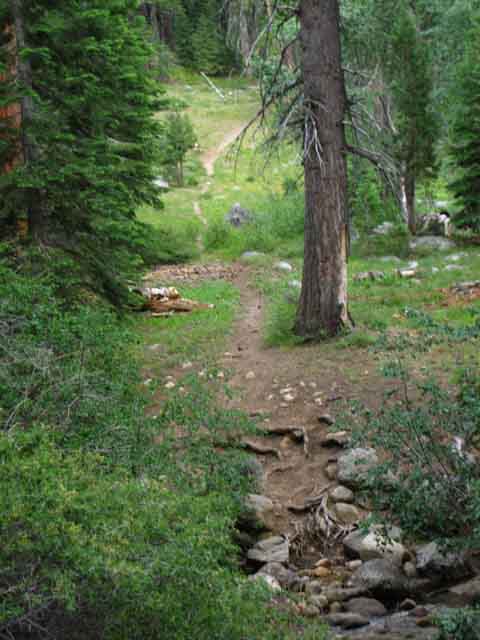 |
||
Tahoe to Yosemite Trail South from Boulder Creek trail junction. Boulder Creek runs past in the foreground. Campsites across Boulder Creek and off to our Right.
|
|
Fewer and fewer foot and hoof prints decorate our trail as we proceed South from the Boulder Lake trail junction until footprints and recent signs of humans end as the trail merges into the terrain. I note the location, extent, and age of tracks across the terrain to better understand the frequency and range of travelers across less-traveled trails. Hell, we engage and observe everywhere... As of July 2012 no recent horse traffic had passed South of the unmarked Eureka Valley trail junction, and footprints only extended a short distance South of this trail junction. This is typical for this location. 2015; Indications of informal trail work above the Eureka Valley unmarked trail junction. It looks like the ranchers have opened up the trail to allow them to ride up to a point approaching, but not quite reaching, the lower ford. It was "informal" trail work because the width of the trail cleared was too narrow for National Forest Trail Crews. |
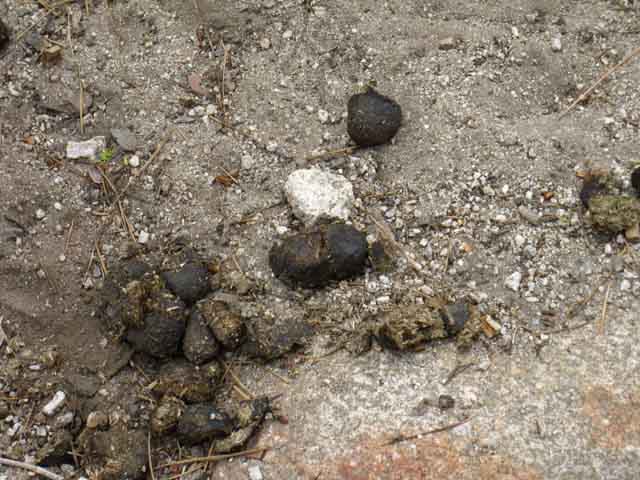 |
||
Horse dung below Eureka Valley and above Boulder Creek. A horse was here about 5 days before, judging by the dryness of the dung against the recent history of local weather. Not much in the way of either foot or hoof traffic on this section of the Tahoe to Yosemite Trail as of mid-July during both 2012 and 2015.
|
|
We hear the falls before we see them. This is the lower of two falls between the unmarked Eureka Valley Trail junction and Boulder Creek. The lower falls has two sections, the upper section of which is composed of many small falls with the Clarks Fork unwinding into many small streams finding their way through a matrix of granite, pictured below. Note the section of stream cutting through the facing rock before tumbling out of the rock as a mini-waterfall in the lower-middle foreground. The scene is as relaxing as the climb is tiring.
|
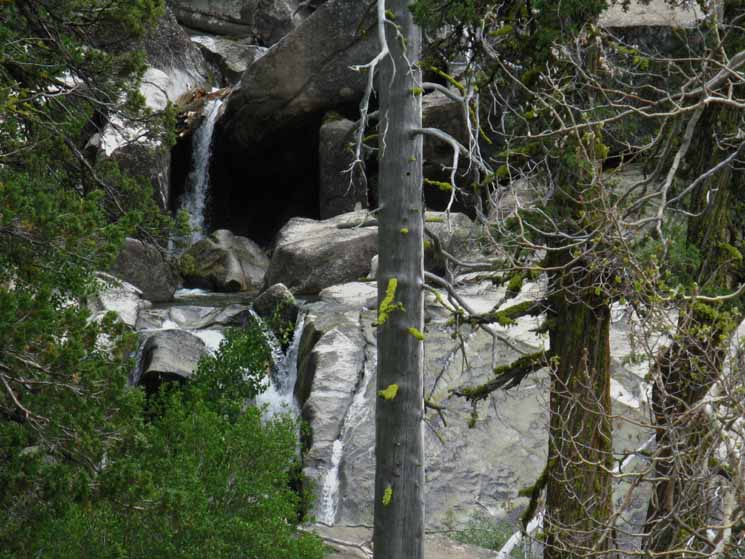 |
Rough Terrain It draws us into its complexity. |
| The larger of the Lower Falls |
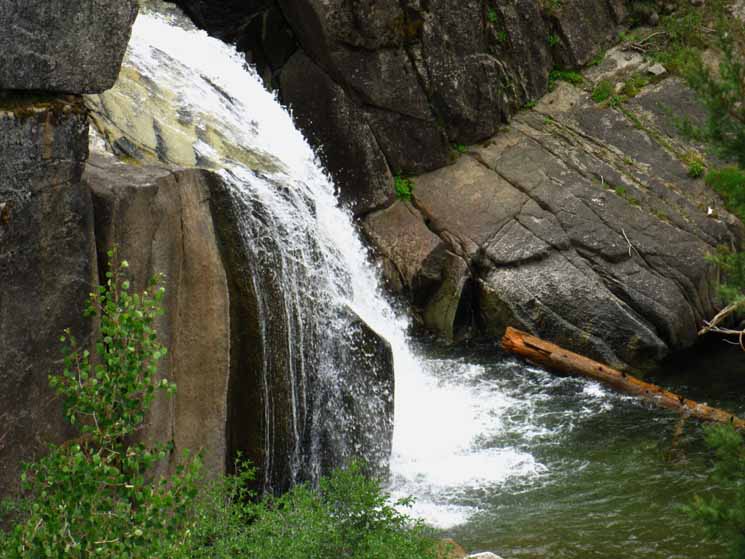 |
||
Lower waterfall above Boulder Creek. This is a very relaxing place along a very demanding trail.
|
Trail Work above the Lower Waterfall Northbound hikers will welcome trail work as continuing sign that maintained trail has resumed. Southbound hikers will note this as one of the last examples of steadily diminishing indications of maintained trail as we continue South. |
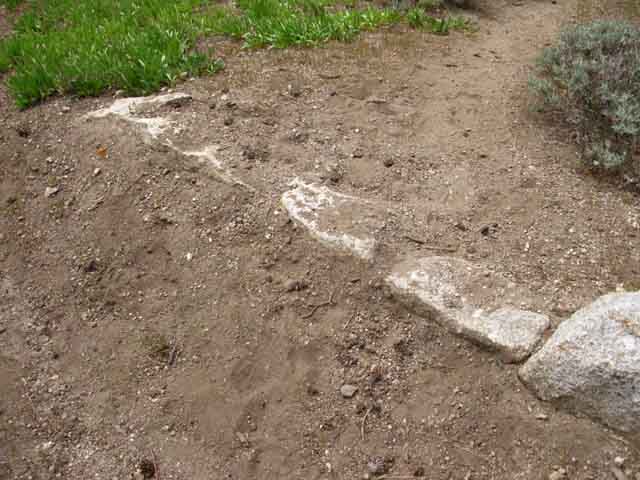 |
Welcome sign of resumption of maintained trail greets Northbound hikers, or one of the last examples of recent trail work Southbound hikers will see.... |
|
I have no idea what this is called. I've figured it out. This is a pussypaw gone to seed. |
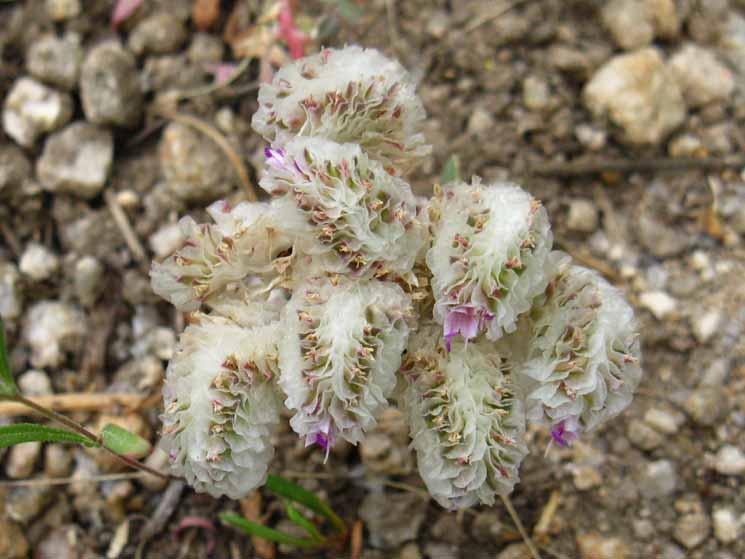 |
It is quite pretty in a complex way. Interesting plant. Tell us what you know. This > Trail Forum < |
Pussypaw
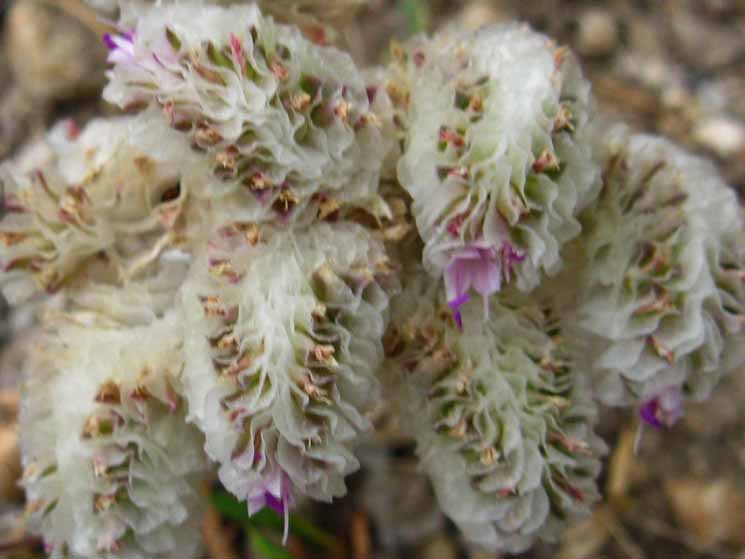 |
Close-up. The flowers here make radical transformations when they go to seed. |
|
The age of the scuff matched the dung at about five days. |
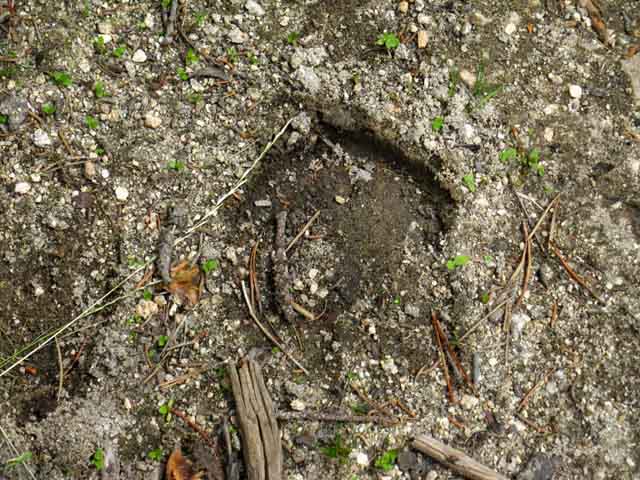 |
||
Hoof print below Eureka Valley trail junction.
|
|
This huge beautiful butterfly flew by and landed, drawing me towards it. This stimulated its further flight, which drew me to pursue. The dance had begun. The butterfly would torture me... After quite a chase I got close enough for only one poor image before this elusive butterfly flew beyond my ability to pursue. I need wings to keep up. I had a heavy pack instead. Call me a "Booterfly." Likely a Satyr Anglewing, if my identification is correct.
|
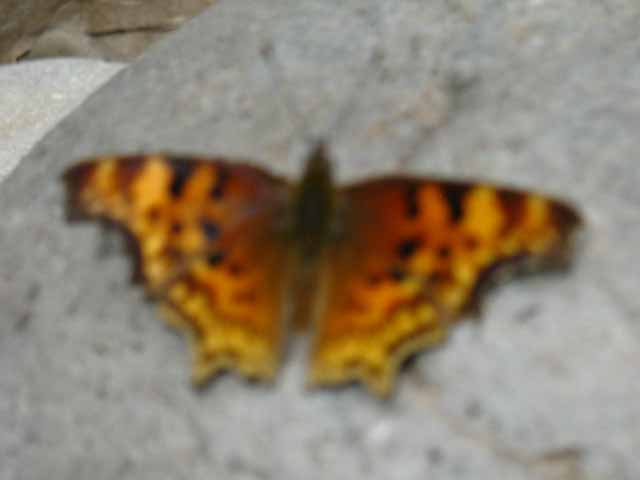 |
||
This guy would not sit long enough to let me get an image. I tried. This guy ran me ragged, but I could not get a clear shot. The little bugger was intent on tormenting me, and I intent on capturing its beauty. This is it, which only reflects a small amount of this elusive creature's beauty and the great energy I spent chasing this one. Little bugger!
I got a clearer image of another of this species up by the upper ford. > Trail Forum < |
|
Yes and No. |
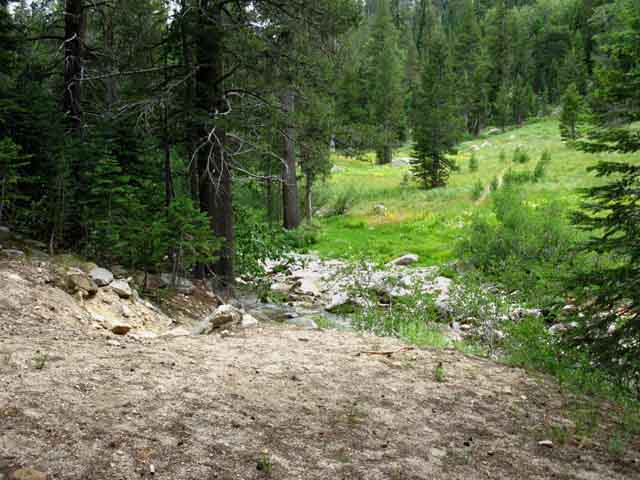 |
||
The Trail to Eureka Valley.
|
Eureka Valley Trail Junction This trail potentially links the old Clarks Fork Road with the route of the Sonora Pass Road, Highway 108. MAPOLOGY Carson Iceberg Wilderness Backpacking Map The 1988 National Forest Carson-Iceberg Wilderness Map show this path as a complete maintained trail from Eureka Valley to the Seven Pines Trailhead on Highway 108. The 2009 National Forest Carson-Iceberg Wilderness Map (pdf) show this path as a maintained trail South to the top of the ridge from the Seven Pines Trailhead on Highway 108, but shows no trail up the North Flank of the ridge from the Eureka Valley trail junction along the Clarks Fork. In contrast to that, the 1979 USGS 7.5 Maps of Dardanelle, Sonora Pass, and Disaster Creek (three maps cover the trail, linked below), show a gap between maintained trails coming North from Eureka Valley on Highway 108 and South from the Clarks Fork of the Stanislaus. Expectations This is no lightweight ridge. It is a massive Sierra ridge. Old Maps When approaching any unknown situations such as presented by this potential route to the Middle Fork via the Eureka Valley junction, as well as our current route Southbound up the TYT through the untrailed section of the Upper Clarks Fork, we must be prepped to both succeed by getting across the unknown section between known trails as well as being ready to fail and be forced to hike back out the way we came in if the trails do not connect, or we cannot connect them. Backpacking requires we account and plan for all possible outcomes of our more aggressive and uninformed explorations. We must have backup plans for our trips across unmaintained routes. Scouting Rumors I was told they found unmaintained conditions across the majority of the route, but I got second-hand information.
Lake Alpine to Saint Marys Pass |
Trail Segment II Images and Guide Film
Carson Iceberg Wilderness Backpacking Map 30 minute USGS topo map
Unmaintained TYT Trail Reports
|
Backpacking Video
Eureka Valley Unmarked Junction NOTE Every video on this Guide depicts Southbound Travel. The Videos above & below contain some segments showing us hiking North along the TYT, the opposite direction as we typically hike. So, these videos are, "bi-directional," composed of some shots as we hike North from Saint Marys Pass through this difficult segment of trail, as well as our typical Southbound segments, hiking South through this upper section of the Clarks Fork Canyon to Saint Marys Pass. After hiking it Southbound for so long, I figured I'd get to know this complex area a little better, and well enough to depict this difficult little section on this guide, by running through on a couple of Northbound trips. Two perspectives are better than one. So, the downhill segments in these videos typically show us hiking North, while the uphill sections depict the Southbound direction, at least until we make our final Southbound descent to the Saint Marys Pass Trailhead on Highway 108. 6:36 |
| Unmarked Trail Junction Eureka Valley |
 |
||||
The unmarked Eureka Valley trail junction. Old Route Our Southbound Tahoe to Yosemite Trail pulls away from the Clarks Fork south of this position to climb around unstable jumbled terrain along the river. South of this point the TYT degrades into unmaintained trail. This combination of the 1985 30 minute maps depicts the old trail-line, Carson Iceberg Wilderness Backpacking Map These 1979 maps don't even show a trail;
|
Bear Poop Our second example along this section of the Tahoe to Yosemite Trail. The dookie higher up the trail was even older than this example, which still contained a bit of moisture. I figure the bear dropped this 5 days earlier. The bear may have been drawn by the smell of the supplies carried by the rider of the horse that left the scuff and dung at about the same time. In any case, indications are of regular bear patrol through the Upper Clarks Fork. I have never found any lack of bears or bear sign in the Southern Carson Iceberg Wilderness. Lots of bears here, as a matter of fact.
|
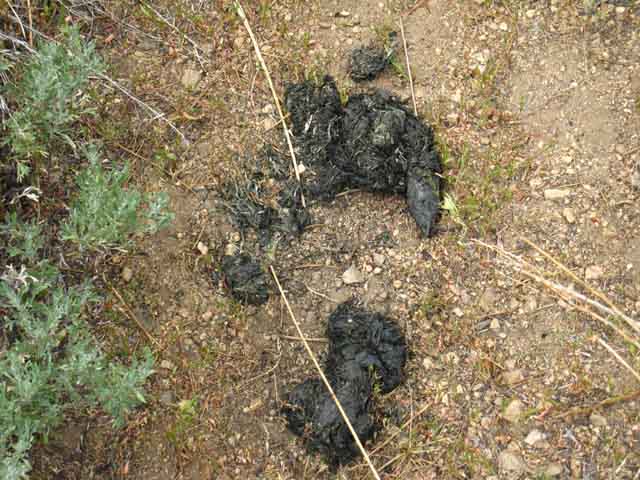 |
||
Above Eureka Valley we encounter fairly old bear scat.
|
|
This is the second of bear decorated trees we encounter between Boulder Creek and our exit from the Headwaters bowl of the Clarks Fork. The tree below does not appear to be a regular target of bear claws as the tree higher up the canyon is. |
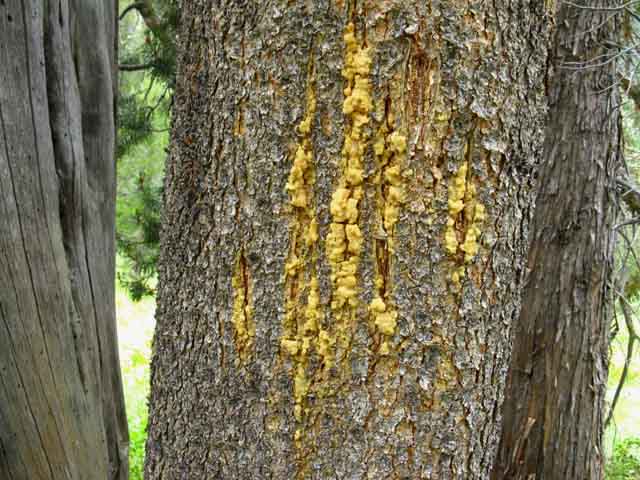 |
||
This is the lower of the two bear sign posts we encounter on the way to Clarks Meadow.
|
| Crimson Columbine |
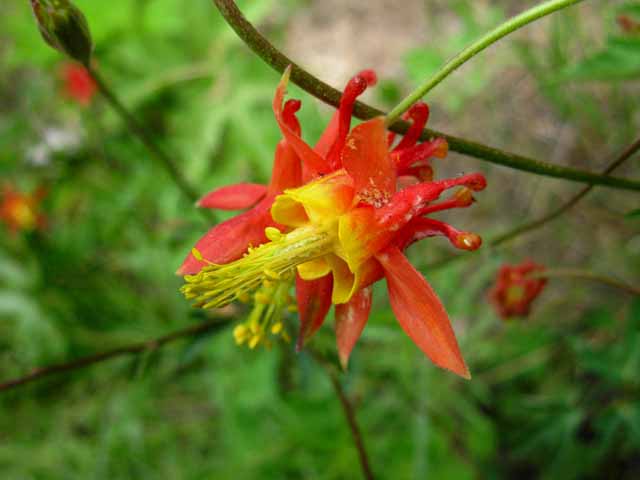 |
||||
Crimson columbine. Color Burst Lots of blooming wildflowers up here all Summer long. Hiking Back to the Sierra Crestline This closeness, the squeezing together of the canyon walls imparts a psychological effect of pushing everything, the flowers, trees, river and rocks all closer together within a narrowing horizontal space. This ninety degree turn South-Southeast by the Clarks Fork Canyon does not just mark our approach to the upper end of the river. The canyon of the Clarks Fork bends South to run under and drain the highest Western flank of the Sierra crestline from Boulder Creek South to Saint Marys Pass. We can see this on the maps. Southern Carson Iceberg Wilderness Back to the Crest Dropping down to and following the Clarks Fork upriver finally brings the Tahoe to Yosemite Trail up to the top of the Western flank of the Sierra. Well, we are now under it, approaching the position of Stanislaus Peak sitting between the East Carson River and the Clarks Fork. Turning South in the Clarks Fork Canyon brings us parallel with the PCT running North-South along the East Carson River's canyon on the other side of this massive ridge making up the Eastern wall of the Clarks Fork Canyon rising above us. We're never really going to make it to the Sierra Crest on the TYT. Saint Marys Pass is situated on a spur off the Western edge of the Sierra Crestline Northwest of Sonora Pass. Saint Marys Pass divides one Western watershed from another, not the Western flank of the Sierra from the Eastern. The Saint Marys Pass Trailhead is about a mile Northwest of, and 200 feet below where Sonora Pass defines the local low spot between the Sierra's Eastern and Western flanks. In the Forums
|
Turning away from the Clarks Fork
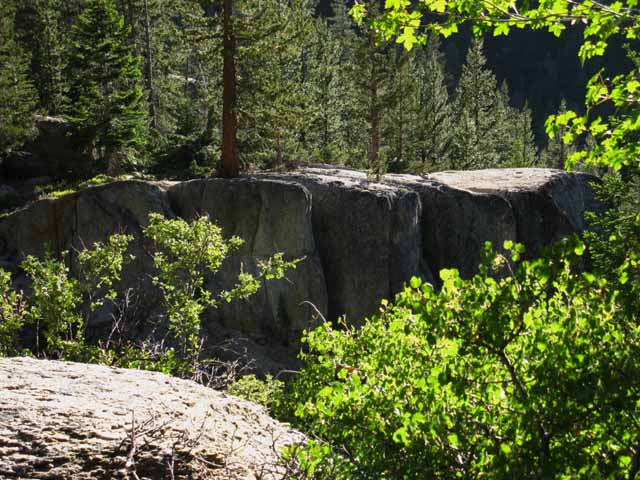 |
| The rocky channel of the Clarks Fork forces our Southbound route up around a jumbled section of the river below. |
Up the Rock Channel
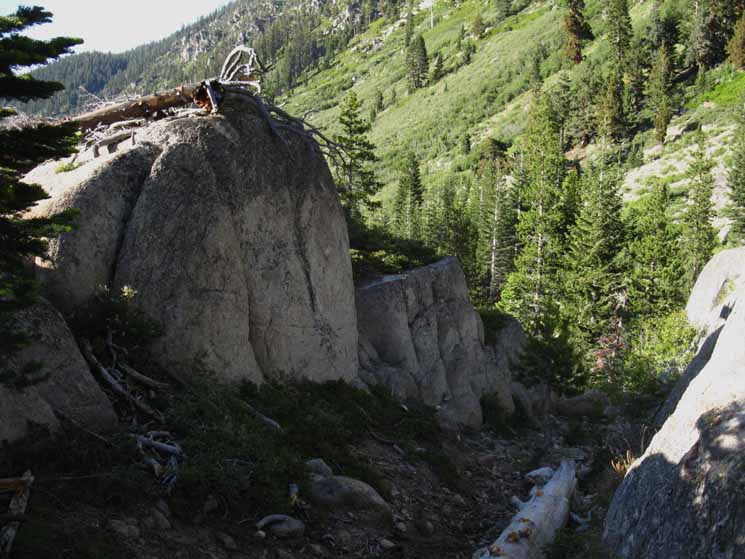 |
| We turn up an avenue lined by rocky giants before we rejoin the course of the Clarks Fork above the jumble. |
View Northwest down the Clarks Fork The Lay of the Land On the Right side of the image we can see what I call the Southern Sharkfin sticking up over the Sierra Crestline marking a specific point on the Pacific Crest Trail route. See that "peaklet" sticking up like a sore thumb along the otherwise smooth Right side of the most distant ridgeline below? That feature is what I call "The Southern Sharkfin," and it marks the South end of Golden Canyon hiking South on the PCT. The PCT passes between it and the Swampy Lake laying under its Southwestern flank, the flank facing us. Here, looking behind us to the North we can see how these two very divergent routes, the TYT and PCT, are drawing towards convergence as they move to their respective trailheads on Highway 108.
But yes, we are looking over the Sierra Crest at the South Sharkfin, and can just make out the crest of Disaster Peak dividing the East and West flanks of this section of the Sierra Crestline on the upper far Left corner of the image below. The map on the Left below shows the position of the Southern Sharkfin, marked on the map as Peak 9501. This map also shows the two trails running over the Sierra Crest to the PCT bracketing Disaster Peak, one just a bit to the North and the other a bit South of Disaster Peak's crest, both coming up from almost the same place along the Disaster Creek Trail. Remember that we hiked past the Disaster Creek Trailhead approaching the end of the Clarks Fork Road, and that the top end of the trail is accessible through the Gardner Meadow Trailhead near Highland Lakes and off the PCT through Wolf Creek Pass.
This terrain to our North that we are looking at could easily make up a substantial part of a backpacking loop crafted around the central Carson Iceberg Wilderness out of the Disaster Creek or Gardner Meadow Trailheads. |
Boulder Creek Junction
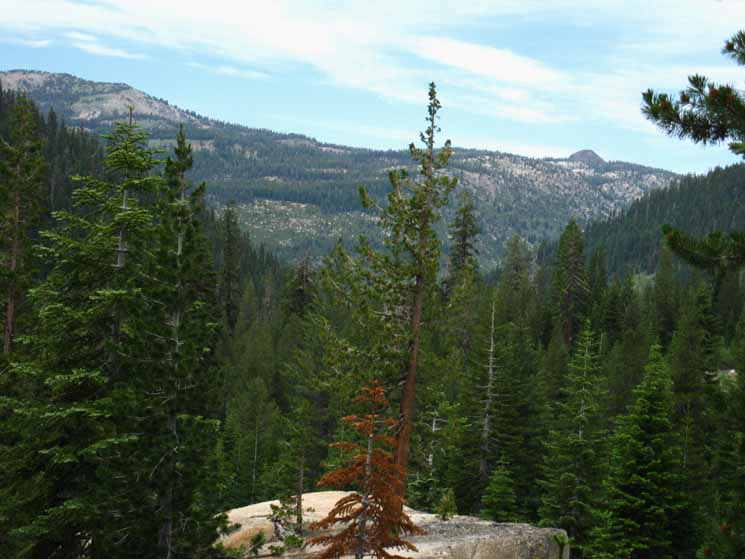 |
||||
Looking Northwest down the Clarks Fork Canyon to where Boulder Creek feeds the Clarks Fork of the Stanislaus River from the North, down from the Right in the image above. Disaster Peak rises on the Sierra Crestline on the Left of the image, and rising like a terrestrial sharkfin on the Right we can see the feature I call the "Southern Sharkfin." That pile of shattered metamorphic rock is located on the South edge of Golden Canyon along the route of the Pacific Crest Trail. The PCT runs North-South over on the other side of the Sierra Crestline along the Northeast Flank of Boulder Peak and around the Southern Sharkfin. I consider the Boulder Lake trail junction the point where our climb South up the Tahoe to Yosemite Trail to Saint Marys Pass begins in earnest, transitioning from the intermediate to Hard level of difficulty.
|
|
As our passage progresses upward on the thinning route we find ourselves passing through a great variety of environments. Across tiny bits of meadow, under great rising rock formations, past stunning waterfalls, and through dense forest, all while climbing pretty steeply at times. This route is like a roller coaster running up a staircase. We have a set of steep ascents broken up by a series of flat and even short downhill traverses and across little bits of almost-level meadow. As we climb further into this mysterious environment and the trail thins out beneath our feet we notice an increasing number of blazes on the wide variety of trees. Apparently this elevation is a sweet spot shared by many species. From Left to Right we have blazes on White Pine, Lodgepole, and Juniper trees. I figure Hemlock and Cedars are around here somewhere... These blazes mark a certain psychological location along the trail, typical of where maintained trails transition into unmaintained route. Hikers venturing beyond the limit of the last blazes marking the easy to follow trails tend to make lots of blazes and ducks when the trail fades and they get a bit nervous. Thus we end up with transition areas between maintained and non-maintained trails being littered with many blazes and ducks, such as this transition zone. |
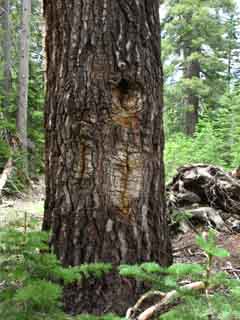 |
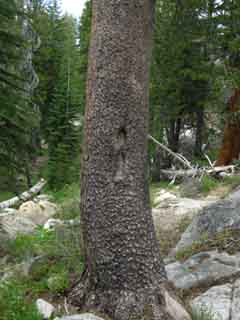 |
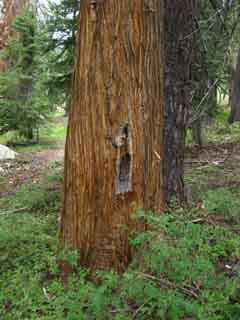 |
||
BLAZE-O-RAMA Unmaintained TYT Trail Reports
|
||||
Thinning Trail |
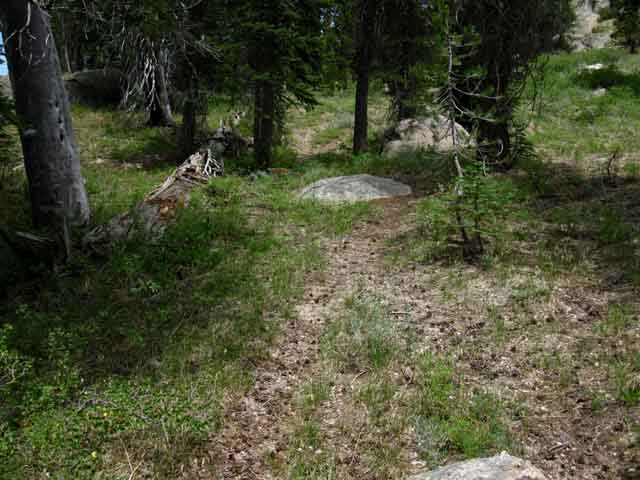 |
Faint but good use trail through a brief flatter section before the climb gets serious again. We've climbed to cut around the river and have dropped back down to it through the forest of blazes into a series of little climbing meadows strung like green pearls along the line of the narrowing river up to the lowest ford. Sections of trail across meadows are vulnerable to rapid degradation. Degradation of trail by the saturation of meadow soils during Fall Storms (yeah, sure...), is dwarfed by the power of the Spring Thaw to tear up trails, which is nothing compared to the power of the bursting out of meadow life during the growth phase of the Spring Thaw. Meadows eat trails. This seasonal dynamic condemns trails crossing meadows to a short life without constant care and upkeep, and therefore rare along unmaintained trails. Meadows respond very differently to heavy hiker traffic as they do to light traffic. Meadows are delicate things. |
|
The Tahoe to Yosemite Trail climbs us up around the route of the river where the canyon walls pinch in. Though still hiking through dense forest and sections of meadow, the rising walls around us remind us the trail is getting, and gets even steeper. |
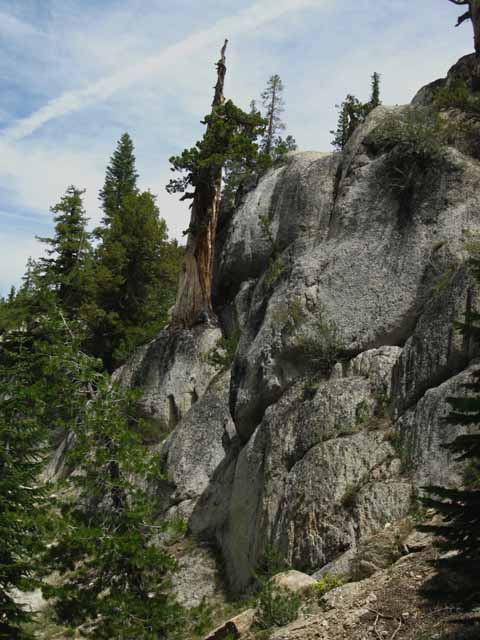 |
Southbound Tahoe to Yosemite climbs into narrowing and steepening canyon. To our East this section of the Sierra Crest is topped by the great volcanic mass of Stanislaus Peak capping all the granite around us under it's great pointy volcanic witch's hat. Stanislaus and Sonora Peaks from Murray Canyon on the PCT. Ancient granite is bursting out, eroding out from under this volcanic cap on both flanks of the Sierra Crest under Stanislaus and Sonora Peaks. Sonora Peak is situated on the South end of this stretch of the Sierra Crest, its volcanic mass towering to the North of Sonora Pass along the main line of the Sierra Crest. Southern Carson Iceberg Wilderness We'll climb onto the Headwaters Bowl of the Clarks Fork looking over at the nearby Western Flank of Sonora Peak as we hike down to the Saint Marys Pass Trailhead on Highway 108. |
Rising Granite Walls
Two Views of the Narrowing Southwestern Canyon Wall
Two Views of the Narrowing Northeastern Canyon Wall
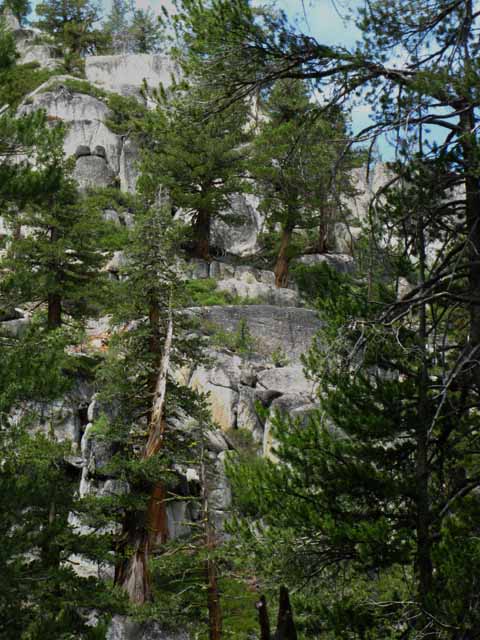 |
||
The rock walls come closer. Here we are hiking through a delightful narrowing granite channel, with faint trails causing us to look closely around at the terrain to maintain our route. Our route finding observations push our attention deeper and deeper into the terrain. Tension-attention, and greater perception. Nature is a great tonic for the human mind.
|
View of the Northeast Canyon Wall
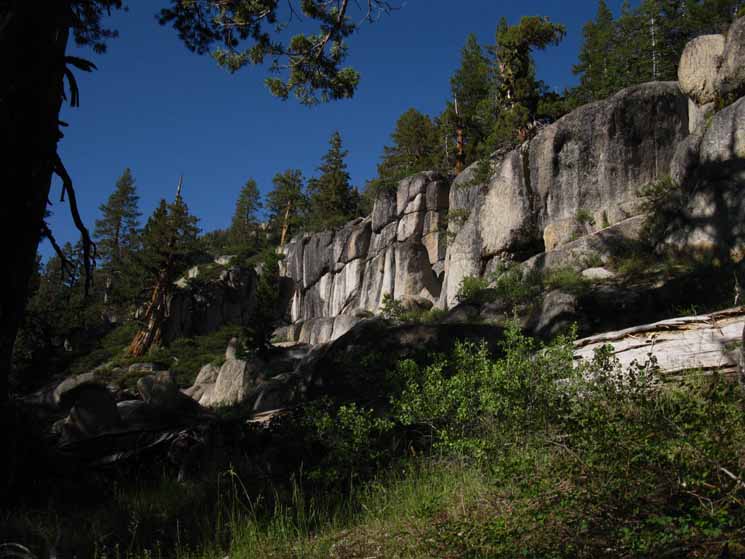 |
| The granite wall to our Northeast tapers down to a nice presentation, or rises up to majestic proportions, depending on our perspective. |
Narrowing Canyon - Rising Walls
SOUTHWEST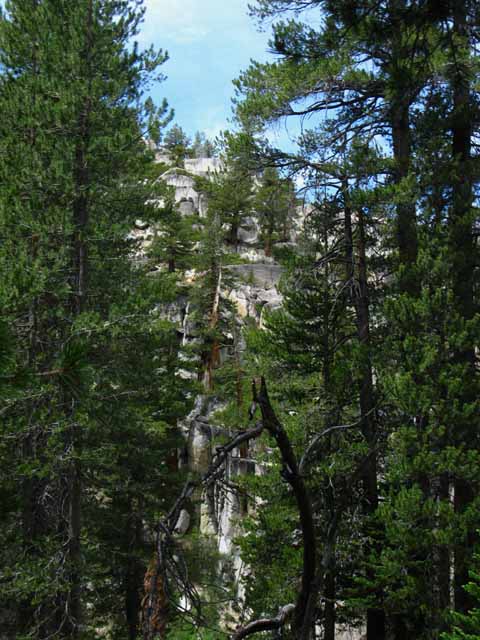 |
Steep terrain climbing South above the Eureka Valley trail junction. Looking across the Clarks Fork at the granite terrain rising on the Southwest wall of our canyon. Hikers on the PCT route on the other side of this great section of High Sierra Crestline who are hiking below the Eastern Flanks of Stanislaus and Sonora Peaks are also hiking into granite terrain. The great masses of Stanislaus and Sonora Peak are great scoops of volcanic terrain sitting atop these exposed granite flanks. Well, they are once they hike South of The South Sharkfin (on the PCT), which is where Southbound PCT hikers come to overlook, and then enter, the magnificent golden granite making up the walls of the middle canyon of the East Carson River. This is interesting. The top of the Sierra Crestline is drowned under, and capped by the remnants of ancient volcanic eruptions piled up on top of great granite terrain exposed on the lower flanks. The power of erosion through the river valleys on both sides of the crestline has cut deep through the soft volcanic material that long ago filled these ancient granite canyons draining the Sierra Crest and its flanks under hundreds, if not thousands of feet of volcanic debris. The power of erosion through the Clarks Fork on the West Flank and the East Carson on the East flank has cut through thousands of feet of volcanic debris to expose the even more ancient granite foundations of the Sierra Nevada buried underneath. Time is washing the softer volcanic material away. The buried granite remained sealed for thousands of years, and is steadily reemerging on the wings of the timeless power of nature, even after being buried under thousands of feet of volcanic debris for thousands of years. It's buried treasure emerging from the sands of time that buried it. Check out the Other Side of the Mountain... |
View of the Northeast Canyon Wall
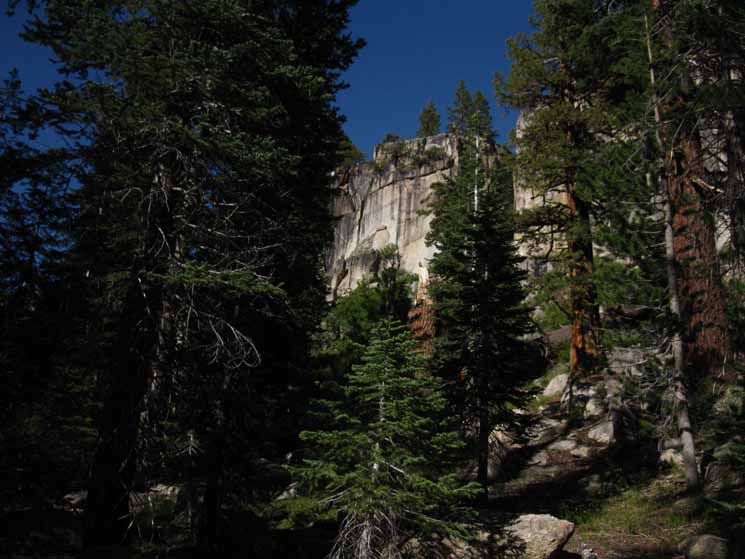 |
| Higher up the granite becomes sheer, still in the lower Clarks Fork below the ford. |
|
Pushing over the trail obstructions and enduring the continuous climb we enter a shaded flat near the river at a position I locate just South of the Mile 14 notation on the USGS map. Southern Carson Iceberg Wilderness Southbound hikers are confronted with the word "NO" blazed on a lodgepole. This rather pessimistic message may reflect the lack of maintained trail South of this point. Who knows what idiots are thinking when they do something stupid. Er, well, I might have some experience there, but I never carve on the face of man or nature. I've been hiking with an idiot for quite some time, and I hike alone! This things he does! This is the furthest South we can get on faded trails before the trail conditions turn considerably worse.
|
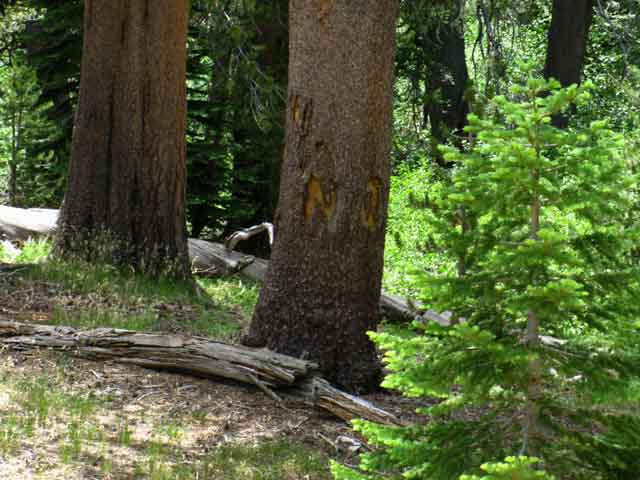 |
||
The big NO. Don't believe it: You can do it. NO
|
Fools Name and Fools Faces...
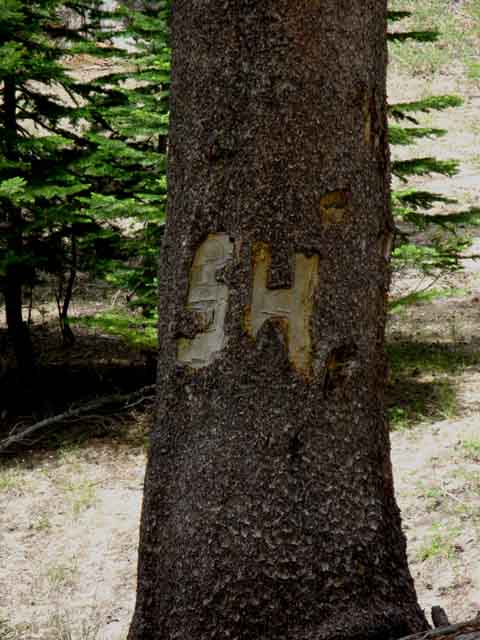 |
Northbound Hikers see this. I really wish people would not cut on the trees. God knows when some of these blazes were originally carved. Westerners started coming through here by 1855 or 1864, depending on which sources you find most reliable. Sonora Pass-Clarks Fork History We also find some subtle petrographs at the middle ford. There are all sorts of non-standard blazes scattered along the route through the Upper Clarks Fork. I suspect that at least a percentage date from the early Western travelers over this route. If you want to see more, walk up to the rise on the North side of the upper ford and check out the blazes up there before crossing the ford. |
|
South of the "No" blaze we encounter increasing obstacles across a steadily degrading trail bed. It really does not matter if you hear a tree fall in the forest when you have to hike over it. Backpackers don't play with reality, they deal with it. Though decent trail bed marks the way South up to the lowest ford there are many segments devoid of any indication of trail while the obvious segments of remaining use trail are crossed by many fallen trees. Add to these obstacles the constantly rising terrain and we have ourselves a trail section that is significantly more difficult than regular maintained trail. And we are just approaching the most difficult sections laying to our South.
|
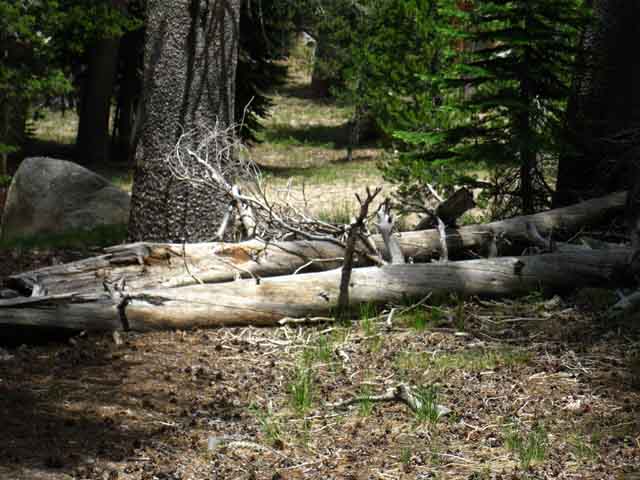 |
||
Obstacles along trail route. Trees have not been "cut and rolled" off the trail for quite some time.
|
Lots of Downed Trees
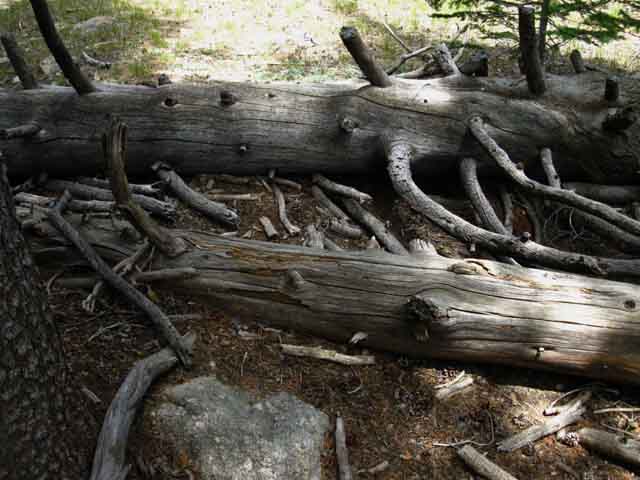 |
Obstacles along trail route. Each and every degradation of trail increases energy consumption. |
Segment III Images and Guide Film Route Distance 8271 to 8370 feet video duration
|
I think there's no better way to get a look at what's behind the maps and miles figures than taking a look at a hiker on the terrain, and seeing how they look and how they're feeling. We also get a good look at the external terrain too! I seem pretty calm here, discussing a series of scouting trips during 2012. |
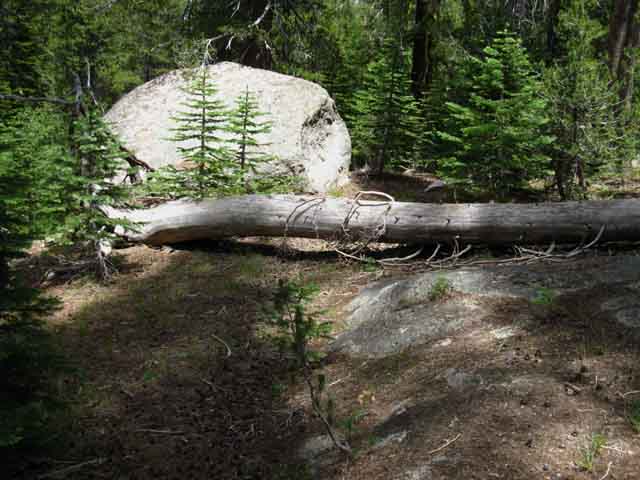 |
||
Near point 8271: Obstacles thicken as we climb South up the Clarks Fork of the Stanislaus. Obstacles and lack of trail noticeably increases our workload.
|
|
Life of a Rock These ancient deeply buried granite plutons were baked up and forced to the surface by the Western movement of the North American continent. As our continent moved West it pushes the Pacific Plate under it. The heat and pressure of this motion generated the Sierra Plutons, and today does things like blow up Mount Saint Helens, and cause massive earthquakes up North in Cascadia. The N American and Pacific Plates are currently slipping along each other's edges, rather than one pushing the other underneath. Current High Sierra Geological Information The power of continental plates conflicting with Pacific Ocean plates has earned the shoreline around the whole perimeter of the Pacific Ocean the nickname of Every now and again something big blows up, or the Earth shakes like you've never seen it shake, around This Ring of Fire. We are not just part of this action, the Sierra Nevada is a product of it. Many of these plutons are composed of a consistent granite material, others are streaked with veins of quartz and differing compositions of various minerals. Those inclusions containing gold and silver generated enough naked greed to warp the very fabric of human history. That is what I believe we are observing below, the interface between differing compositions of granite materials baked up within this ancient pluton. How this got here is mind boggling. This inclusion likely consolidated into a discrete band in an otherwise uniform mass of molten minerals after thousands and thousands of years of cooling. It then underwent hundreds thousands of years of slow uplifting, of granite being surfaced, cracked open and weathered down as the Sierra pushed up out of the Earth. Then the freezer turned on, and so began thousands of years of the unimaginable forces of glaciation finally cutting down to, but not grinding this fragile inclusion into gravel. Similar included interfaces are visible on the other side, the East side of Stanislaus Peak along the East Fork of the Carson River. Geology and Terrain Forum |
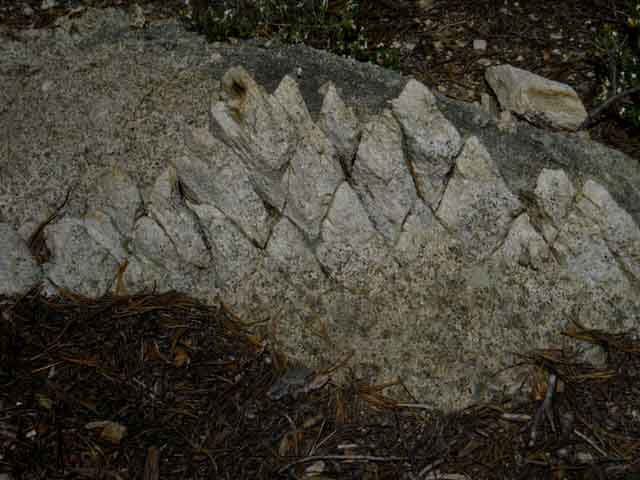 |
A short way off the route I noted an interesting mini-geological feature to check out. |
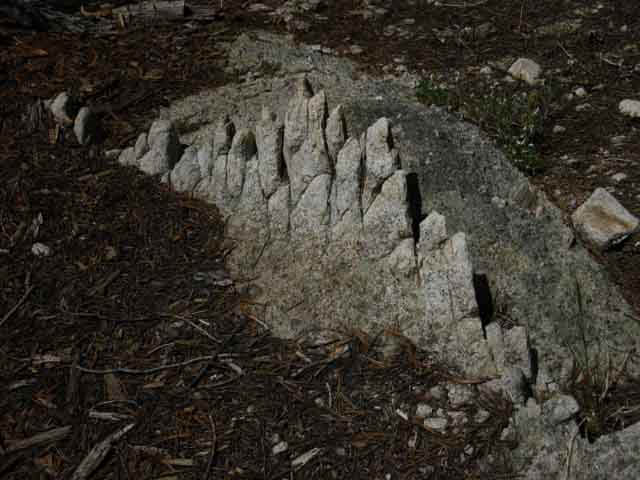 |
||
It appears to be an inclusion, a layer of a differing granite recipes between otherwise uniform layers. The Sierra Nevada has produced a sculpture of itself.
Geology |
|
The upper waterfall sits between the Eureka Valley unmarked trail junction and the lowest ford of the Clarks Fork of the Stanislaus River. |
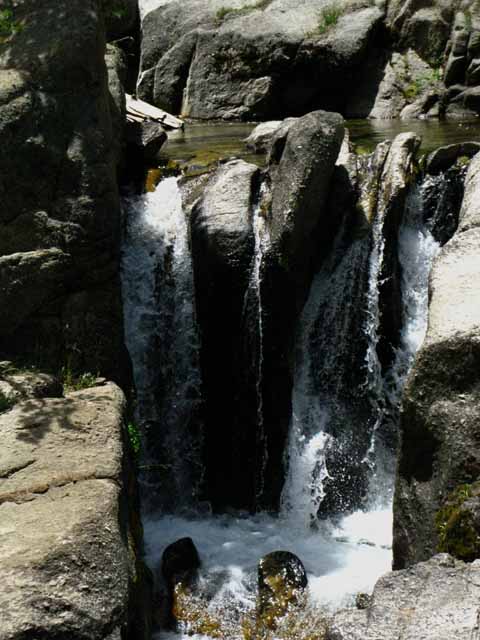 |
||
Upper waterfall along Clarks Fork below Clarks Meadow.
|
|
This bear post is much more active than the bear-decorated tree we encounter lower down the Clarks Fork. |
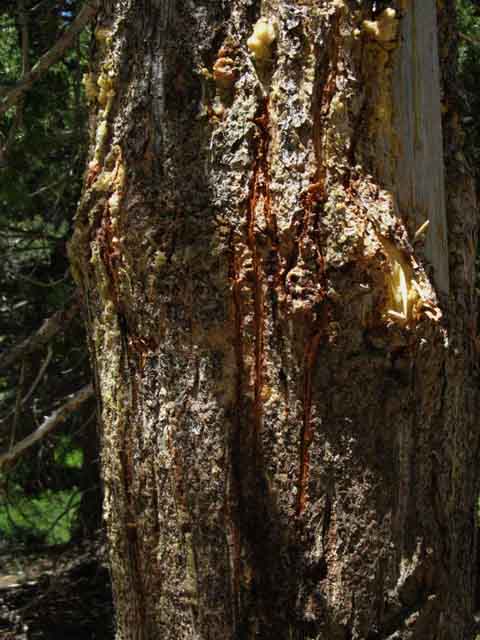 |
||
Well decorated bear sign post. The meadows around here are wetter, and likely more productive of the grubs and insects bears seek than those lower down the Clarks Fork. Thus bears might spend more time here than down there. The next segment of trail South to the lower ford is through a bit flatter terrain, with even more and soggier stretches of river and meadow wedged in between narrowing canyon walls, though still climbing. Our route skirts around the North side of the river, trying to stay as high above the wetness as possible. Trail Skills
|
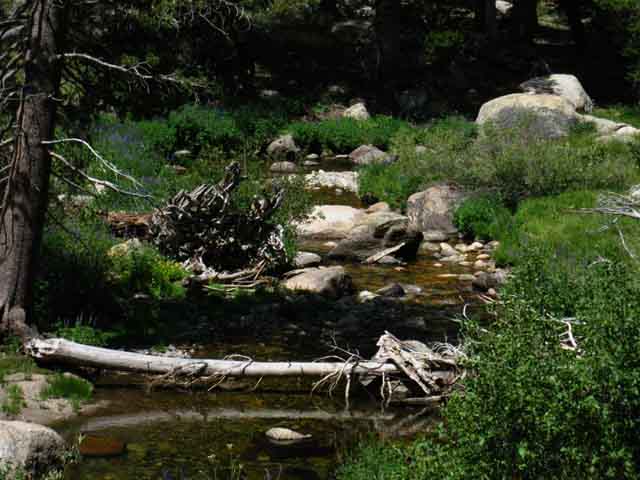 |
||
Clarks Fork ambles through a meadowed flat below the lowest ford, where a large tributary coming off the South wall of the canyon feeds the Clarks Fork.
|
|
The canyon walls move closer, the route grows fainter, and we continue to climb through segments of rising forest into sections of climbing meadows quickly followed by yet another climb. |
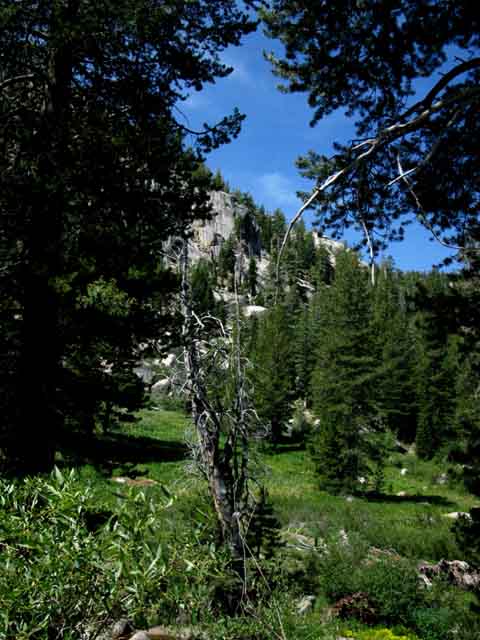 |
||
North of the lower ford the terrain flattens and the canyon widens a bit. Note the rising angle of the meadow up the mountain. The trail sticks to the North and East wall of the canyon to stay above the wetness of the meadows along the river's banks.
|
|
Our arrival at the lowest ford is marked by easy to see ducks on the South bank of the river. Note that the power of the Spring thaw may remove existing ducks. |
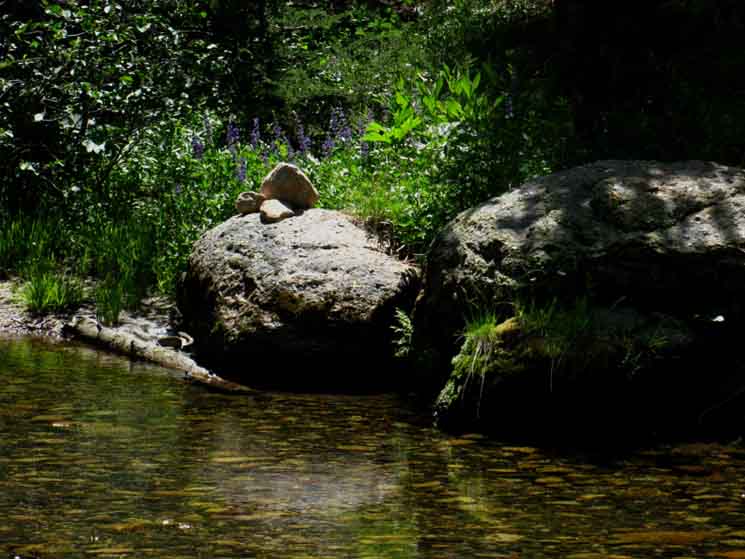 |
||||
Duck on the South shore of the lowest ford of the three fords across the unmaintained segment of the TYT through the upper Clarks Fork.
|
Next Trail Guide Page Images and Guide Film Route Distance 8370 to 8800 feet video duration
Unmaintained TYT Trail Reports
|
We find our way down to the lowest ford from the North edge of the Clarks Forks Meadow at the middle ford in this video. We have to find and keep on the use trail and keep our eyes wide open to follow the faded bits of use trail and wild ducks linking the middle and lower fords. |
North: Jenkins Canyon to Boulder Lake junction South: Lower Clarks Ford to Saint Marys TH
Our progress down the |
|||||||||
Completed: Total difficult 8.69 mile Segment of the Tahoe to Yosemite Trail:
Forum
Sonora Pass Region Map
30 min topo hiking Map
Next page South |
|
|||||||||||||||
Backpacker Forums Have a great Sierra Nevada trip or story to relate? A fine piece of gear? Or gear that failed?Post it on If you have specific experiences, comments, questions, or pictures and videos of the Pacific Crest Trail between Lake Alpine and Saint Marys Pass, Post up here:Forum Section
|
North: Jenkins Canyon to Boulder Lake junction South: Lower Clarks Ford to Upper Ford
HELP Along with help from my friends and family. THANKS! If you feel these efforts are valuable to you, This is the first full and free classic trail guide of, on, and for the web. A True "Digital Book" from cover to cover. |
Trailhead
Contact
Alex Wierbinski

Backpacking Lake Tahoe to Mount Whitney
Your Guide to the High Sierra Crest, including the Tahoe to Yosemite, Pacific Crest, and John Muir Trails

